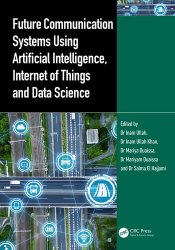 Название: Future Communication Systems Using Artificial Intelligence, Internet of Things and Data Science Название: Future Communication Systems Using Artificial Intelligence, Internet of Things and Data Science
Автор: Inam Ullah, Inam Ullah Khan, Mariya Ouaissa
Издательство: CRC Press
Год: 2024
Страниц: 253
Язык: английский
Формат: pdf (true)
Размер: 16.0 MB
Future Communication Systems Using Artificial Intelligence, Internet of Things and Data Science mainly focuses on the techniques of Artificial Intelligence (AI), Internet of Things (IoT) and Data Science for future communications systems.
The goal of AI, IoT and data science for future communications systems is to create a venue for industry and academics to collaborate on the development of network and system solutions based on Data Science, AI and IoT. Recent breakthroughs in IoT, mobile and fixed communications and computation have paved the way for a data‑centric society of the future. New applications are increasingly reliant on machine‑to‑machine connections, resulting in unusual workloads and the need for more efficient and dependable infrastructures. Such a wide range of traffic workloads and applications will necessitate dynamic and highly adaptive network environments capable of self‑optimization for the task at hand while ensuring high dependability and ultra‑low latency.
Networking devices, sensors, agents, meters and smart vehicles/systems generate massive amounts of data, necessitating new levels of security, performance and dependability. Such complications necessitate the development of new tools and approaches for providing successful services, management and operation. Predictive network analytics will play a critical role in insight generation, process automation required for adapting and scaling to new demands, resolving issues before they impact operational performance (e.g., preventing network failures and anticipating capacity requirements) and overall network decision‑making. To increase user experience and service quality, data mining and analytic techniques for inferring quality of experience (QoE) signals are required.
Data Science is basically utilized to extract meaningful information generated by Artificial Intelligence of Things (AIoT) devices. This will open new opportunities for researchers, engineers and scientists. The merger of AI, IoT and Data Science will enhance communication systems.
This book provides detailed information about future communication systems. Also, it explains the relationship between AI, IoT and Data Science. Each chapter presents technological advancements, solutions, ethical considerations and opportunities. This book presents a detailed guide for researchers and practitioners about future communication systems.
The broad discipline of deriving information and insights from data is covered by Data Science. Big Data refers to huge and complicated datasets, whereas Data Analytics and Big Data Analytics both include the study of data, with the latter addressing data analysis more generally and the former concentrating primarily on large‑scale datasets. AI‑powered Big Data analytics holds tremendous potential; however, it also brings multiple drawbacks, especially when confronted with uncertainty. There are seven important Big Data Vs—velocity, verbosity, variety, versatility, volume, veracity, and value, all introduce different types of uncertainty that can affect the quality and reliability of data. Some types of uncertainty in Big Data include measurement uncertainty, incompleteness, and imperfect, or noisy data. The whole analytics process, including data gathering, organization, and analysis, can be affected by uncertainty. The majority of data mining and ML approaches face a significant hurdle when handling ambiguous and incomplete data. Furthermore, biased training data may prevent ML algorithms from producing optimal results. According to Wang et al., uncertainty considerably influences how well Big Data analytics function, highlighting six primary problems. Dealing with the uncertainty present in large datasets is a different issue, and data mining and ML algorithms frequently face similar difficulties. Big Data is now typically categorized as datasets in the Exabyte (EB) or Zettabyte (ZB) categories. However, smaller datasets still provide difficulties.
AI, IoT, Machine Learning, reinforcement learning and network data analytics innovations open new possibilities in areas such as channel modeling and estimation, cognitive communications, interference alignment, mobility management, resource allocation, network control and management, network tomography, multi‑agent systems and network ultra‑broadband deployment prioritization. These new analytic platforms will aid in the transformation of our networks and user experience. Future networks will enable unparalleled automation and optimization by intelligently gathering, analyzing, learning and controlling huge volumes of information.
Скачать Future Communication Systems Using Artificial Intelligence, Internet of Things and Data Science
|